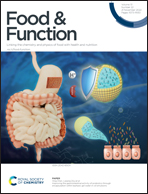Kiwicha (Amaranthus caudatus L.) protein hydrolysates reduce intestinal inflammation by modulating the NLRP3 inflammasome pathway†
Abstract
The increase in the world population along with new policies aimed at a more sustainable world has led to the need of searching for new food sources, which are environmentally friendly, implying healthy and nutritious diets. This study explored the biological activity of two kiwicha (Amaranthus caudatus L.) protein hydrolysates obtained with the aid of Bioprotease LA-660 regarding their anti-inflammatory response at the intestinal level, employing the CACO-2 cell line. The results obtained showed that the in vitro administration of these hydrolysates decreased the expression of proinflammatory cytokines, increased the expression of anti-inflammatory cytokines, and decreased the gene expression of the major components of inflammasomes in the intestinal CACO-2 cell model. To the best of our knowledge, this is the first study involving the evaluation of the anti-inflammatory activity of kiwicha hydrolysates at the intestinal level, employing the CACO-2 cell model and its ultrastructural characterization using scanning electron microscopy. We conclude that the Amaranthus caudatus hydrolysates are a valuable source of active peptides that take part as functional ingredients in food and nutraceutical preparations.



 Please wait while we load your content...
Please wait while we load your content...